
When the Critical Social Justice (CSJ or “woke”) movement emerged fully into the public sphere around 2015, Gender Critical Feminists were there. As CSJ rapidly gained control of vital institutions, established itself as the dominant moral orthodoxy and instituted a Cancel Culture capable of destroying the lives of anybody who dared to dissent, a movement by women, for women and about women was ready for it. As an element of the Radical Feminist movement which had long held that “gender” was an oppressive social construct which constrained women (and men) into restrictive gender roles and stereotypes that disempowered women, it was well-read, organised, committed and politically active. While liberals scrambled to respond to this new authoritarianism that seemed to have burst out of nowhere from a benign and largely positive movement to oppose racism, sexism, homophobia and other bigotries, the woman-centred Gender Critical Feminist movement knew what it should be doing. It held the line.
The line held by Gender Critical Feminists was clear and bright. It held that women, as a sex class, had interests that were bound up in their biological sex and those interests needed to be protected. Women, as the sex that could get pregnant, needed good reproductive healthcare and control over their own reproductive function. As the sex that was smaller, weaker and the targets of sexual predators who were overwhelmingly male and heterosexual, they needed sex-based rights. These included single-sex spaces where they were vulnerable, single-sex sporting categories where they were at a disadvantage against the stronger, faster, and just more physically “dense” sex and single-sex shelters where those who had been abused could recover and try to rebuild their lives. Self-ID laws and social norms which enabled men, including those who were violent and sexually predatory, into these spaces and sporting categories were a threat to women’s sex-based rights and to their safety and ability to compete fairly in sports. They must be resisted.
When Gender Critical Feminists made these arguments and organised around protecting women’s sex-based rights, the Critical Social Justice movement responded. It claimed the feminists were transphobic and motivated by hatred of trans women, that they cast them as sex offenders, sexual deviants, and paedophiles in ways reminiscent of homophobic attacks by the far-right on gay men and that they were misogynistic in painting women as weak, vulnerable, and poor athletes. It even claimed that Gender Critical Feminists were dangerous, denying trans-identified people the right to exist and fuelling a culture of transphobia which got a vulnerable minority murdered and caused young people to commit suicide.
Throughout all this, Gender Critical Feminists held the line. They responded to their critics that they were not motivated by hatred of trans people but by the need to protect women’s sex-based rights and asserted that pointing out biological reality was not hateful. They refuted claims that their objections to biological males in women’s spaces were motivated by far-right style paranoia and distaste for sexual minorities and restated their position that everybody should be free to live as they pleased but not in women’s spaces and sports if they were male. They provided evidence of their own commitment to the rights of same-sex attracted people and pointed out that Trans Rights Activism which sought to bully lesbians into having sex with people with penises and gay men into feigning a sexual interest in vaginas with accusations of transphobia was itself homophobic and reminiscent of the mindset underlying conversion therapy.
Feminists insisted that they were neither misogynistic nor misandrist and that their claims of women’s lesser strength, speed and muscle and bone density and their claims that the vast majority of sex offenders were men were just straightforwardly, demonstrably, objectively true. They clarified, endlessly, that their position on gender being an oppressive social construct meant that they regarded the concept of gender identity, like gender roles and gender stereotypes, as unrooted in reality and harmful particularly to women. Not believing gender identity to exist as a material reality is not the same as a murderous desire to end the existence of people who identify as trans or to drive them to suicide. There is no evidence that any such murder or suicide was ever committed or inspired by feminists or feminism. Many feminists said they were not unsympathetic to trans people facing hostility, prejudice or violence, but that their activism was for women, that women were allowed to advocate on behalf of themselves and did not have to also take on the issues faced by trans-identified men and that they were in favour of trans people creating their own spaces, sports and shelters as women had done.
A turning point in this battle was effected by the arrival of J.K. Rowling upon the Gender Critical scene in 2019 holding this line magnificently. Speaking of the case of Maya Forstater, she tweeted,
Dress however you please.
Call yourself whatever you like.
Sleep with any consenting adult who’ll have you.
Live your best life in peace and security.
But force women out of their jobs for stating that sex is real?
#IStandWithMaya #ThisIsNotADrill
And followed this up the next year with,
If sex isn’t real, there’s no same-sex attraction. If sex isn’t real, the lived reality of women globally is erased. I know and love trans people, but erasing the concept of sex removes the ability of many to meaningfully discuss their lives. It isn’t hate to speak the truth.
The idea that women like me, who’ve been empathetic to trans people for decades, feeling kinship because they’re vulnerable in the same way as women - ie, to male violence - ‘hate’ trans people because they think sex is real and has lived consequences - is a nonsense.
I respect every trans person’s right to live any way that feels authentic and comfortable to them. I’d march with you if you were discriminated against on the basis of being trans. At the same time, my life has been shaped by being female. I do not believe it’s hateful to say so.
These statements and this stance and this much-loved bestselling author became focal points of the Gender Critical Feminist movement to the point where billboards in support of the Gender Critical view simply said “I <heart> J.K.Rowling” (and were also identified as transphobic and removed by authorities captured by the Critical Social Justice movement). So reasonable and liberal was this stance that it mobilised people outside the movement who had also grown increasingly alarmed by the authoritarian CSJ movement. They began to recognise that the Gender Critical movement was the most organised, committed and, likely, effective, way to push back CSJ at least in the realm of Trans Activism, and give it their support.
What was it about Rowling’s encapsulation and amplification of the Gender Critical Feminist position that resonated with so many people who were not Gender Critical Feminists across the political spectrum? I think it is clear that it i s that it is liberal. “Liberal,” in this sense, is not opposed to “conservative” but to “authoritarian.” At the heart of the liberalism that underlies the ideal of secular, liberal democracy is one simple principle, best defined as,
Let people believe, speak and live as they see fit, provided it does no material harm to anyone else nor impinges upon their right to do the same.
It is important to have a clear understanding of and high bar for what constitutes material harm here. It cannot include beliefs, speech or actions which are considered subversive, hurtful, worrying, or bad for society. Authoritarians very commonly justify their authoritarianism by claiming it to be for the imposed-upon people’s own good. Every theocracy that has ever existed has claimed its heresy and blasphemy laws and its persecution of religious minorities to be for the good of society and even the heretics, blasphemers, and infidels themselves. The CSJ movement justified its no-platforming, cancelling, firing and intimidation of Gender Critical Feminists on the grounds that their beliefs and speech were harmful or even violent to trans people. People with a strong conviction that their own beliefs are true and good will frequently justify the suppression of those whose beliefs they perceive to be false and bad. It is not a good argument to say, “But my beliefs really are true and good” because everybody always thinks that. It would be incoherent not to.
This is not relativism which holds that all sincerely held beliefs are equally valid or have equal probability of being correct. It is liberal pluralism which holds that people have the right to hold a wide range of beliefs including those which are wrong. By protecting that right consistently and continuously, we uphold societal norms where the wrong are not denied their individual liberty and the right have a chance of being heard and effecting change when the dominant moral orthodoxy is wrong. As we can now see that there has never been a time in which the dominant moral orthodoxy was right about everything, it is important for the sake of both freedom and truth to hold that line.
This line can be and is held by people all over the political spectrum, from the patriotic American conservative defending the right to “life, liberty and the pursuit of happiness” to the Marxist arguing for the value of dialectic. Consequently, the rightness and importance of the Gender Critical Feminist cause as encapsulated and amplified by Rowling was clear to a much wider range of people, half of whom were women and nearly all of whom cared about women. The line really had been crossed between believing, speaking and living as one sees fit and causing material harm to others and interfering with their freedom to do the same. Placing women in a position where a sex offender can self-identify as a woman and gain access to places where women are vulnerable ranging from changing rooms to shelters to prisons does cause material harm to women. Nobody has to believe that trans women are inherently sexually predatory to acknowledge this reality. Material harm is also caused when a female athlete loses her winning place and potential scholarships, sporting career or financial reward because somebody with the benefits of male puberty competes against her (or charges into her). The rallying cry of “Let Women Speak!” was particularly powerful to the liberal mind and so liberals on the left, right and centre increasingly began to demand that right.
Because so many people are fundamentally liberal in the sense of “anti-authoritarian” and because the cause was presented to them as fundamentally liberal, thus quelling fears of appearing to be prejudiced against a minority group, the Gender Critical Movement gained critical support. Increasing numbers of people joined the #LetWomenSpeak hashtag and more and more media outlets covered the issues sympathetically. People began to apply the term “gender critical” to themselves to signal their disbelief in gender identity and support for sex-based rights. This included many people who were not feminists or even, strictly speaking, gender critical. Many believed that much of what people think of as ‘gender’ and speak of in terms like “masculine,” “feminine,” “manly,” “womanly,” or, more loadedly, “butch” or “effeminate” are products of traits naturally occurring more in men or women because of their evolved brains and hormones rather than culturally conditioned roles operating in the service of patriarchy. They didn’t even have to believe in patriarchy.
This made significant impact on public discourse and changes began to occur, especially in the UK which has been dubbed “TERF Island” due to a particularly strong Gender Critical Feminist movement. Laws began to change protecting incarcerated women from being imprisoned with a male sex offender, a consensus began to emerge about protecting women’s spaces and new rules making women’s sports categories based on sex were made. The Labour Party in the UK reversed plans to strengthen the ability to self-identify as a woman legally and the likely next Prime Minister seems to have been convinced that not recognising women to be adult human females would do the party’s chances more harm than good. The world’s largest gender clinic for children, the Tavistock, which has long been a source of concern for its ideological bias towards the CSJ movement, has been closed on the grounds that its interventions were” based on poor evidence and its model of care leaves young people “at considerable risk” of poor mental health”.
There is still a great deal of work to be done to completely protect women’s spaces and sports and provide evidence-based care for gender distressed youth, but the signs that CSJ “queer theory” approaches to sex and gender are being pushed back are clear. This was achieved by the organised, dedicated commitment of the Gender Critical Feminist movement and as a woman and a mother, I am profoundly grateful to you all. However, it was also achieved by Gender Critical Feminists holding that liberal line that enabled liberals to support it and there is significant cause for concern that that line has been shifting for some over the last couple of years and particularly over the last few months.
I am referring, of course, to what has come to be called the “Civil War” or “schism” occurring within the Gender Critical Movement between those still holding the liberal line and those descending into authoritarianism and tribalism. Interestingly, it is the latter who most frequently accuse the former of not “holding the line.” This authoritarian turn appears to be caused by a combination of factors. It includes the ever-present influence of the more dogmatic Radical Feminist element, some of whom have always been scathing of liberal feminists and open in their antipathy to men, now feeling emboldened by some important wins to expand their activism to controlling the speech of everyone and the clothing choices of men. Some of it is also explained by the inclusion of illiberal social conservatives in the movement who never wanted to abolish the concept of gender or gender roles but to tie them more strongly to biological sex and enforce them more militantly. Some of it is surely caused by sheer Culture Wars fatigue and the fraying patience and consistency of the battle weary.
Although this authoritarian element has been growing for some time, the really serious fracture lines in the movement became evident to those on the peripheries in the last few months and correlate with the first two sentences of Rowling’s influential tweet.
Dress however you please.
Call yourself whatever you like.
The Gender Critical Movement as manifest on social media fractured significantly over the incident of the “Man in a dress” at the Genspect conference last November. Some Gender Criticals argued that the problem was that this man (who identified as a man and did not enter the women’s lavatories) was open about his autogynephilia and so was forcing women to participate in a fetish. Others genuinely just had a problem with a man in a dress. Although a man wearing an item of clothing perfectly decent on women while behaving entirely appropriately in a public place cannot reasonably be considered to be sexually violating anyone (no matter what anyone might imagine to be going on his mind), suggesting this generally resulted in being accused of a fetishist enabler and a pervert. The same response was forthcoming to the reminder that the Gender Critical Feminist position had always been in favour of gender nonconformity as a way of disrupting gender stereotypes. Arguments were made by people describing themselves as Gender Critical in favour of banning men from wearing dresses by law, by social shaming and even, very occasionally, by violence.
This is clearly a divergence from the Gender Critical Feminist line that accepts people’s right to “live any way that feels authentic and comfortable to them” and positively encourages men to embrace any role or presentation culturally coded as “feminine” rather than reinforcing stereotypes by claiming that a wish to do so makes them a woman. As Nina Paley said “The Man In A Dress causing the uproar knows he's a man, looks like a man, makes no pretensions to not be a man, doesn't claim to be a "lesbian," and doesn't use women's spaces. He wears a dress as an unambiguous man. He exemplifies what GC insisted was OK 5 years ago.”
Principled Gender Critical Feminists are holding the line.
This has continued to escalate until now the extreme position is that we are to assume that anybody who appears to be male and wears a dress is not only an autogynephile but a sex offender and should be publicly vilified and fired from any job that involves working with children. The comments below refer to Debbie Hayton, a transsexual who supports the aims of the Gender Critical movement.
Principled Gender Critical Feminists continue to hold the line.
The fracture over the use of preferred pronouns came to a head a couple of days ago and again involved Debbie Hayton whose book on transsexualism from a gender critical perspective has just been published. The influential Gender Critical Feminist, Janice Turner, wrote a positive review of it while referring to Dr. Hayton as “she” and “her” and immediately disappeared under a pile of Gender Criticals interested purely in condemning her use of pronouns rather than discussing the gender critical content of the book.
Principled Gender Critical Feminists held the line.
A few days later, the author, comedian and GB News presenter, Andrew Doyle, who has dedicated a significant amount of his programming to defending women’s spaces and sports and defending Gender Critical Feminists being cancelled, was himself subjected to a particularly nasty attempt at cancelling him from the Gender Critical Movement. He too had interviewed Debbie Hayton on her (deal with it) new book and also mentioned that he uses preferred pronouns as a courtesy with some friends. Again, the content of the discussion and its significance for the Gender Critical Feminist movement was of no importance to the individuals who swarmed his Twitter account demanding he stop using wrong-sex pronouns and/or attacking his character and motivations and/or hurling misandrist and homophobic insults.
Again, principled Gender Critical Feminists held the line:
It seems it was this last incident that decided Doyle on giving up on trying to speak to people on Twitter and move to Substack. While he seems mostly to blame the platform for bringing out the worst behaviour in the worst trolls of all groups, principled Gender Critical Feminists have rightly taken exception to this treatment of him on both a strategic and an individual level. I admit that I do too. If Andrew Doyle is a misogynist, he is exceptionally good at hiding it underneath a skilful veneer of respect for my work and general courtesy and kindness. I also appreciate his ability to disagree with me occasionally without deciding I am the antichrist. That’s always good. As he said:
I was repeatedly accused of being a misogynist, something which I find odd, given that over the past few years I have covered the rising threats to women’s rights on my show with a tenacity that has been notably absent in other media outlets. Every week I have invited women to appear, including Helen Joyce, Maya Forstater, Jo Phoenix, Julie Bindel, Alka Sehgal Cuthbert, Milli Hill, Kellie-Jay Keen, Dr Jane Clare Jones, Jo Bartosch, Mara Yamauchi, Holly Lawford-Smith, Sarah Phillimore, Kate Coleman, Rosie Kay, Ayaan Hirsi Ali, and Sharron Davies. If my critics are correct, and I am indeed a rabid misogynist, surely I at least deserve some credit for going to such elaborate lengths to disguise it?
This is at the root of the problem with the authoritarian, purity-demanding, character-assassinating faction of the current Gender Critical Movement. It simply is not true that anybody who disagrees with the purists on any detail or fails to live up to their increasingly stringent demands is now a Trans Rights Activist who hates women and wants children to be mutilated. Calling Andrew Doyle a misogynist and pervert (because he is gay) is not a good faith attempt to persuade him that using female pronouns for trans women even in his private life is disrespectful to women & undermines gender critical aims. It's homophobic abuse.
Similarly, repeatedly telling me that I am fat and generally physically repulsive and a ‘pick me,’ ‘handmaiden of the patriarchy’ or ‘dick panderer’ seemingly without a mind of my own if I say that men should be able to dress as they like, everybody should be able to choose their own words and nobody should be abusing trans people is not a good faith attempt to change my mind on any of those. It is misogynistic abuse. Behaviour like this is an attempt to intimidate someone out of ever expressing a dissenting opinion again as well as any witnesses who were thinking of it and create a cancel culture within the Gender Critical Feminist movement. That must not be allowed to happen, both because it is exceedingly unjust to individuals and because it will destroy the movement from the inside while losing the support of ethical people from the outside.
This “circular firing squad” mentality is one of the prime weaknesses of the Critical Social Justice movement and the one that will ultimately make it destroy itself. Some of the people watching the Gender Critical Civil War have suggested that the authoritarians have learnt the “ways of the woke.” No, this kind of “cancel culture” production is the marker of all ideological zealots and purists. We have just become accustomed to seeing it from the Critical Social Justice movement over the last decade. Aside from the ethics of it all, the Gender Critical Feminist movement, while tenacious, is too small to create a Cancel Culture that can restrain anybody but itself. Its strength comes from the public support it has been able to achieve by holding the liberal line. It cannot expect to keep that support if it does not hold that line. While there is still so much work to do to protect women’s spaces and sports and demand evidence-based care for gender-distressed youth, the self-sabotaging behaviour of the zealots is a serious mistake.
To keep its support, the Gender Critical Feminist movement must maintain the ethical stance that earned it in the first place. In order to have the backing to “Let Women Speak,” it needs to permit others to speak too. It cannot define “women” as “exactly the right kind of Gender Critical” and then attempt to silence everyone else. Women won’t tolerate being “dewomaned” if they disagree in the slightest. To retain the support of gay men, it needs not to indulge in homophobic slurs when angered by the tiniest hint of dissent. To retain the support of all the men currently supporting it, it cannot resort to vicious misandry in the face of honest disagreement. Gender Critical Feminism was at its strongest when its assertions, so well encapsulated by J.K. Rowling, that its motivations were not hatred for trans people but the need to protect women were supported by its actions. It cannot maintain any moral credibility when prominent figures seen as belonging to it are calling for firing trans women and publicly vilifying them or any man wearing a dress in the street. Trans Rights Activists are already glorying in being “proven right” in their claims that Gender Critical Feminism is just far-right homophobia recycled and that the focus on spaces and sports is just a cover for a wish to abuse trans people. The movement cannot survive the perceived shifting of its line from the liberal stance of “Let people believe, speak and live as they see fit provided it does no material harm to anyone else or impinges upon their right to do the same” into everything dark, hateful, illiberal, small, and mean that its enemies claimed it to be.
Principled Gender Critical Feminists are already well aware of this, and I am greatly relieved to see more of them assertively identifying and addressing the problem. Many of these divisive, hateful commentators are not of them, but they are operating under its “GC” banner and trying to make common cause with them. It is essential to draw a clear line between their stance and the principled Gender Critical Feminist one.
I am very familiar with the tendency to minimise a problem occurring on one’s own side because of a feeling that, while this contingent may be a bit extreme, their motivations are surely good, and the other side is so much worse. This was the attitude among my own tribe – the liberal lefties – that allowed us to get in this mess in the first place. “Surely,” my people thought, “the aim for “Social Justice” can only be a good thing and if some people are a little overzealous and not altogether rational in opposing racism, sexism, and homophobia etc, they are only a minority, and their hearts are in the right place unlike the racists, sexists, and homophobes.” Well, look how that misguided complacency turned out.
I have been very vocal on the subject of the authoritarian purists seeking to create their own Cancel Culture within the Gender Critical Feminist movement over the last few weeks, largely because of a lot of it has been aimed at me since I agreed to be an advisor for Genspect. This piece is intended to be my last word on this subject for now. I have highlighted the problem as I see it. It is not within my power to have much influence at all on the movement as it is not my movement. Continuing to criticise its authoritarian turn can only harm it and hinder the principled members of it who are best placed to address the problem. I do not want to do that as it is a movement which, when it holds the line, helps women and children. I will continue to try to help it in the way I do best – studying and critiquing the Critical Social Justice Movement and defending the rights of the Gender Critical Feminists (along with everyone else) to speak. We must now rely on the movement to fix itself. I think they will hold the line. That’s what they typically do best.



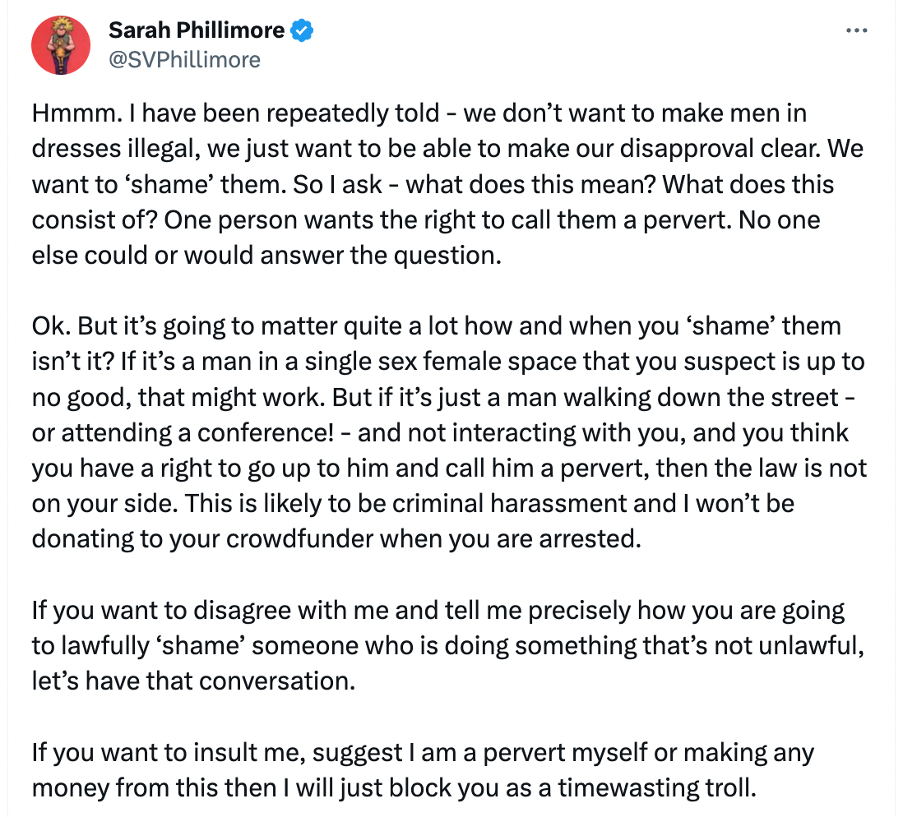

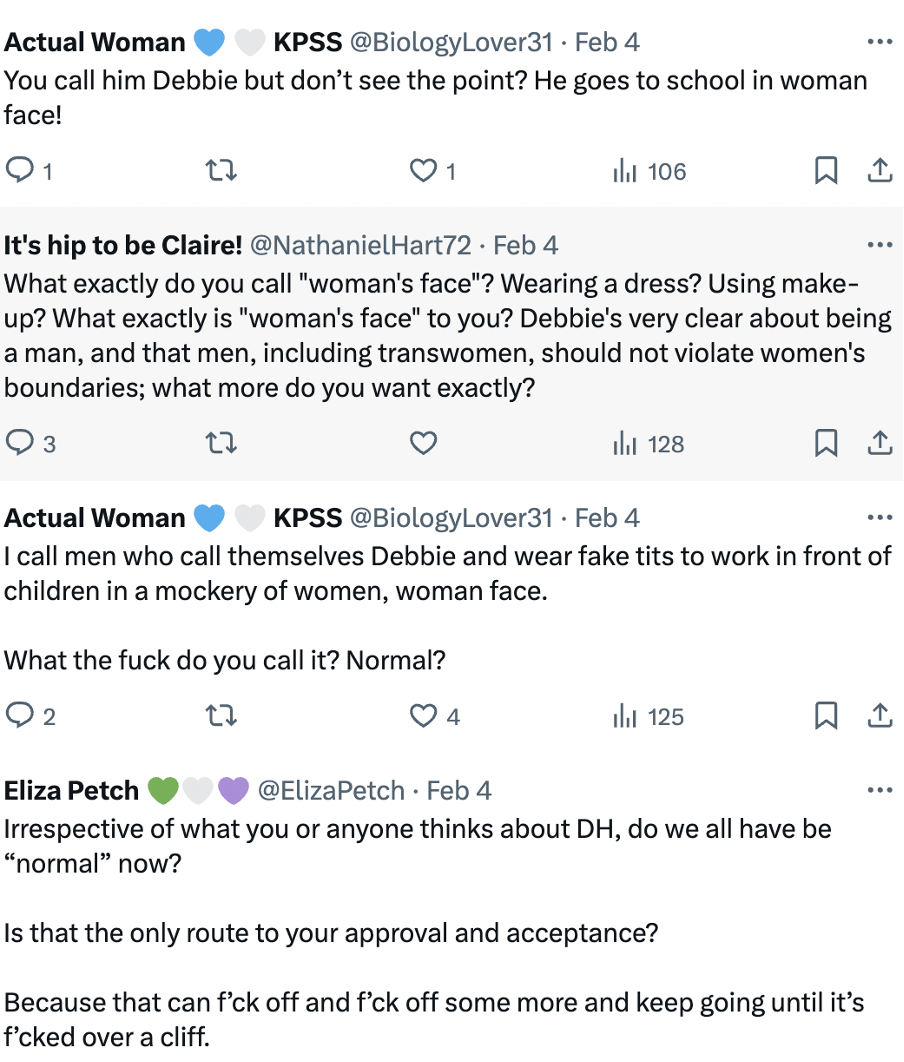
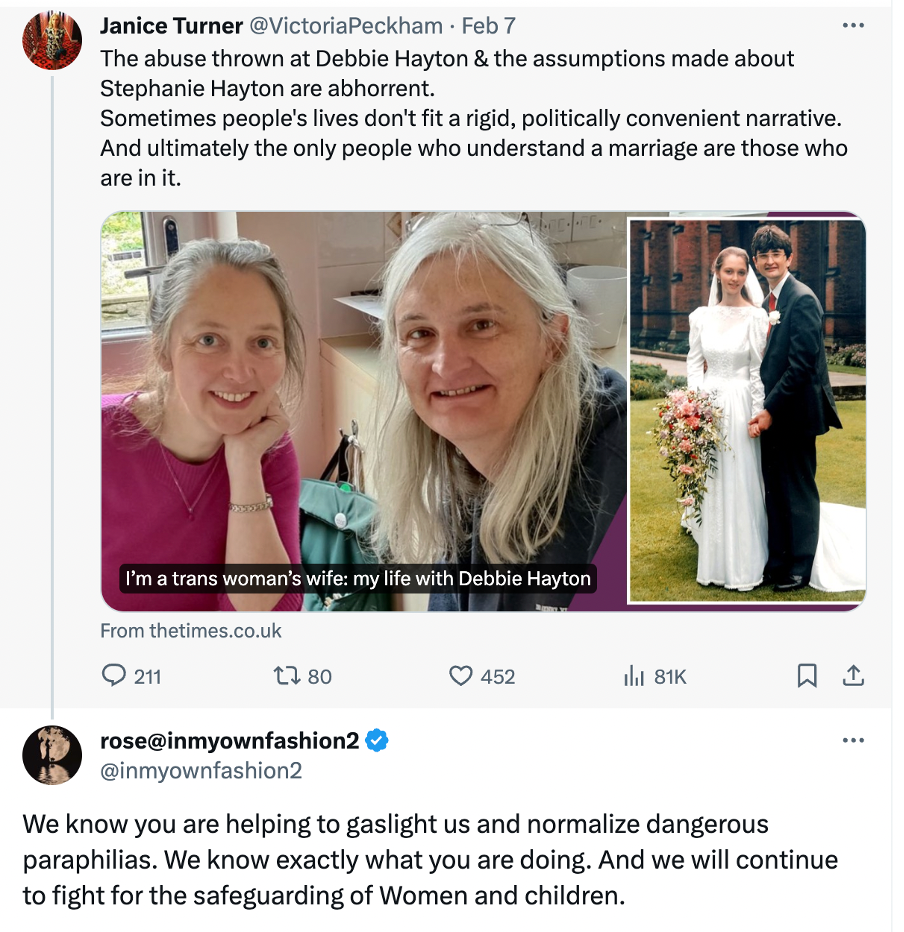

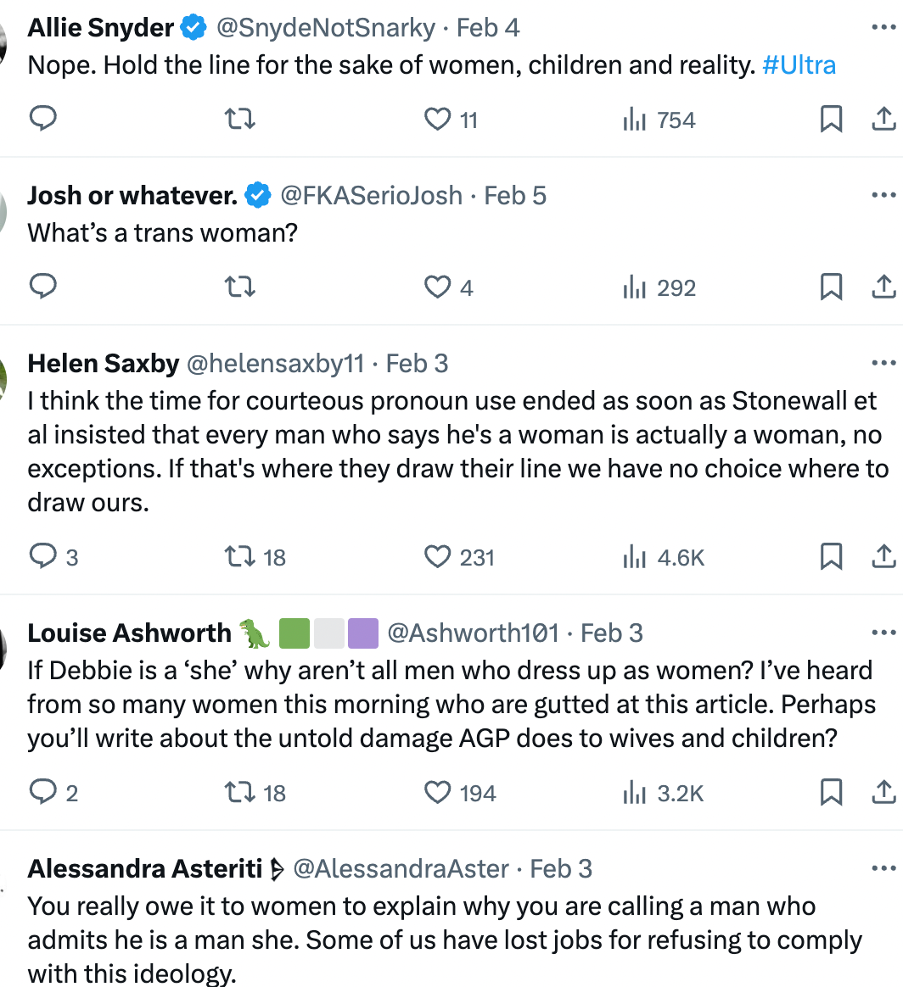
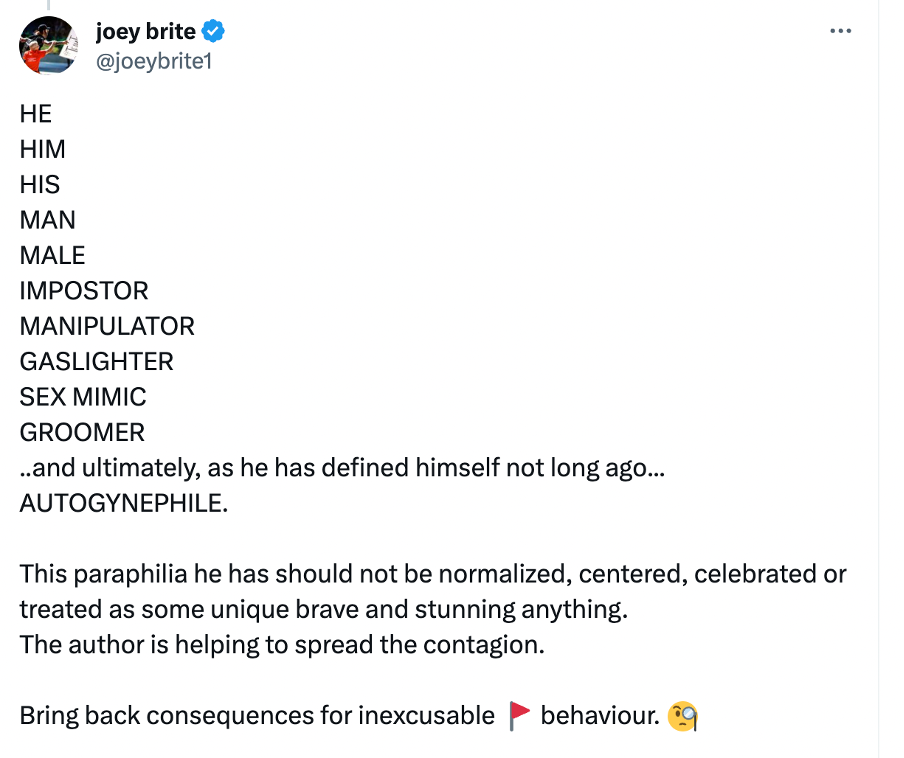
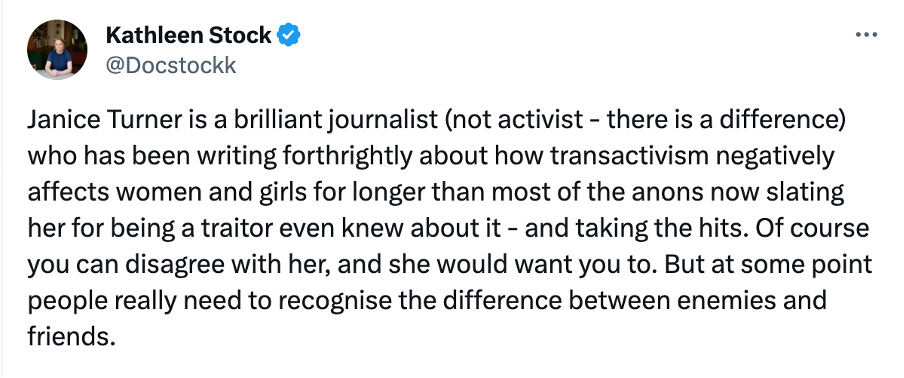

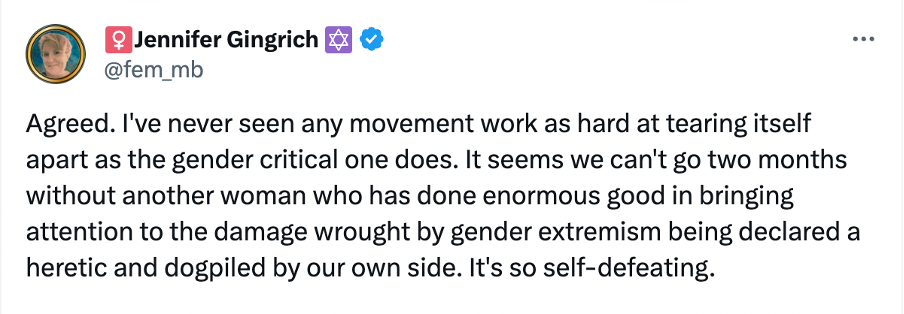
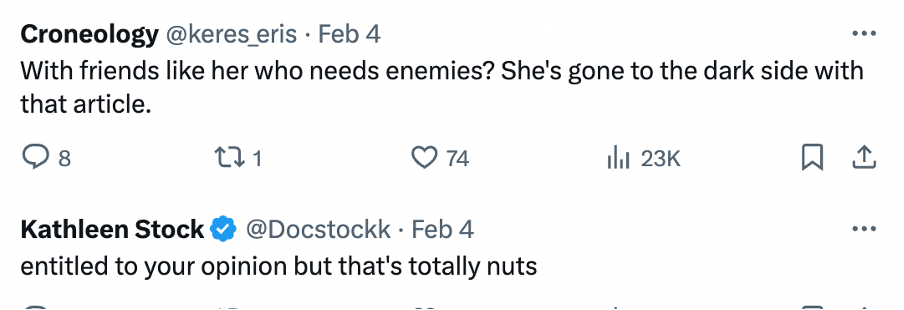
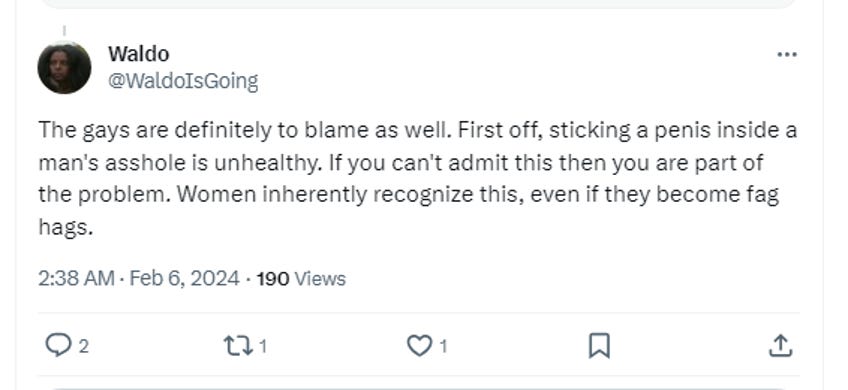
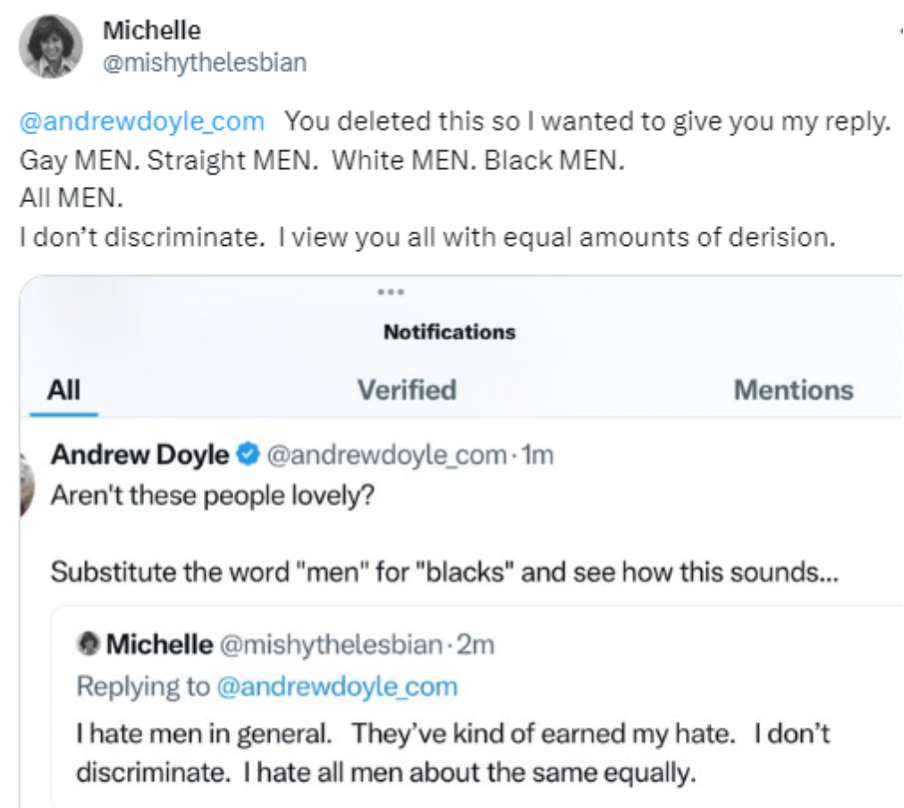
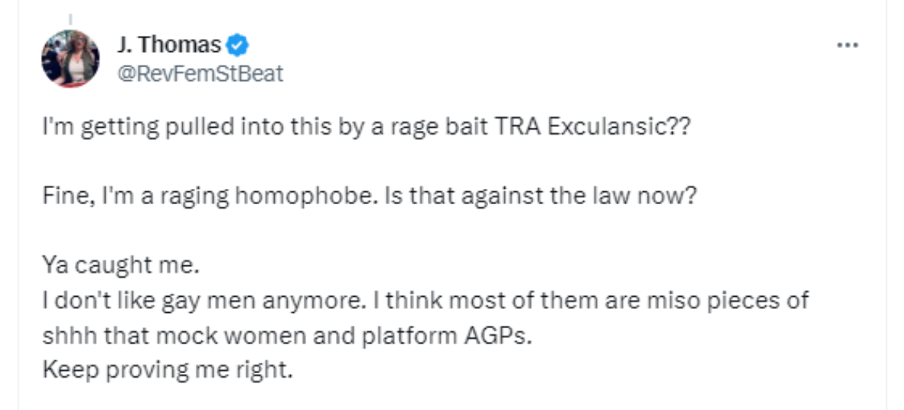

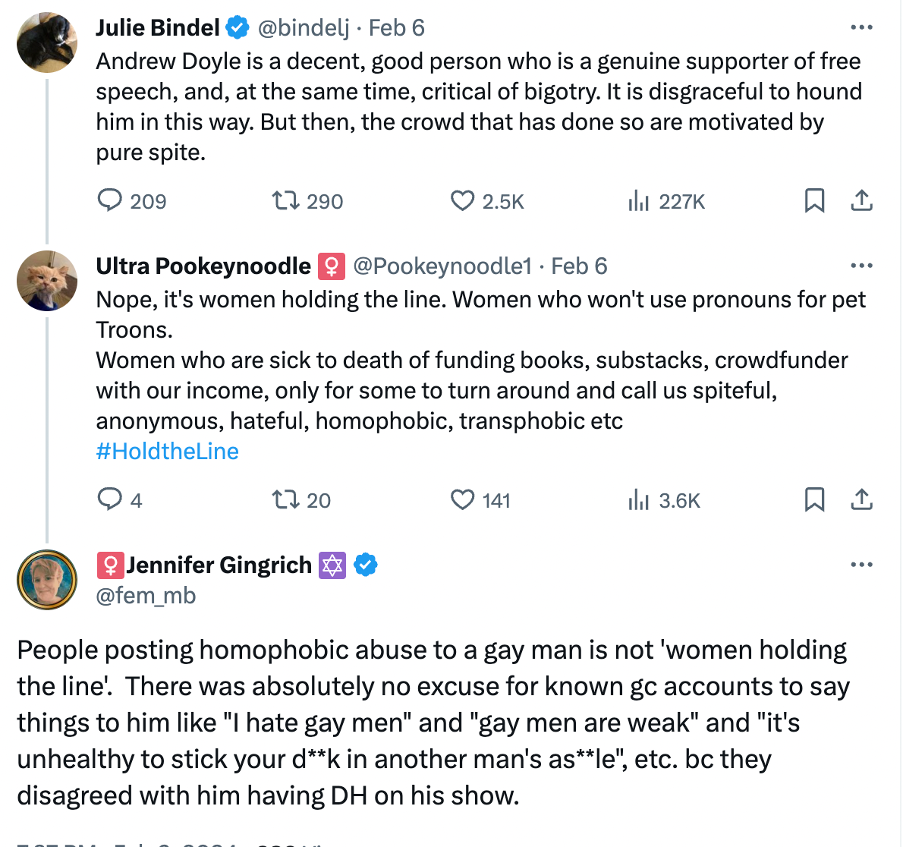

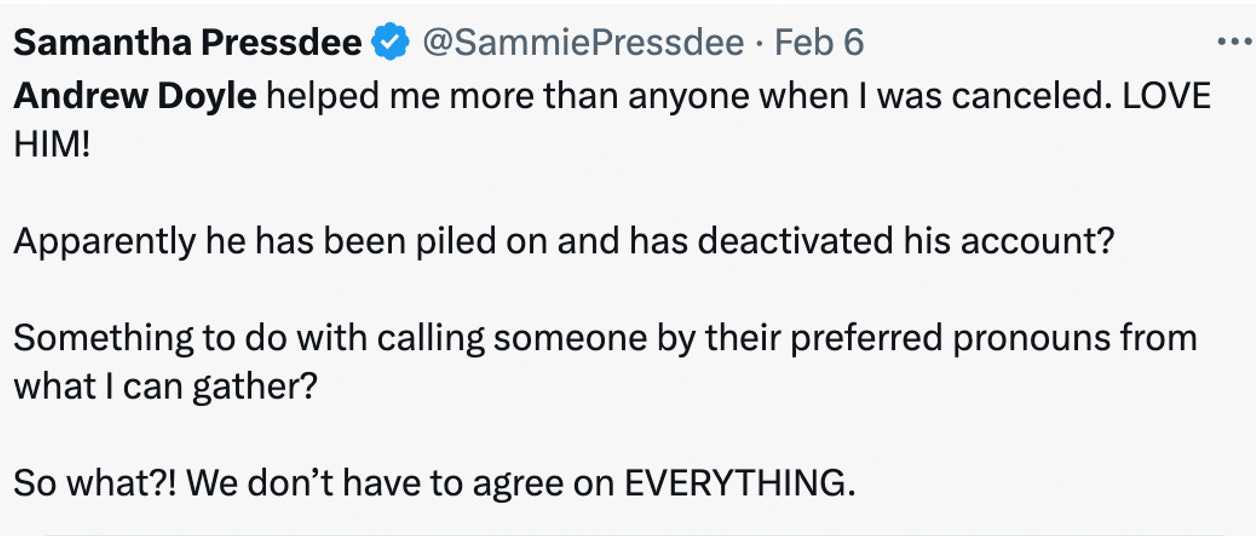
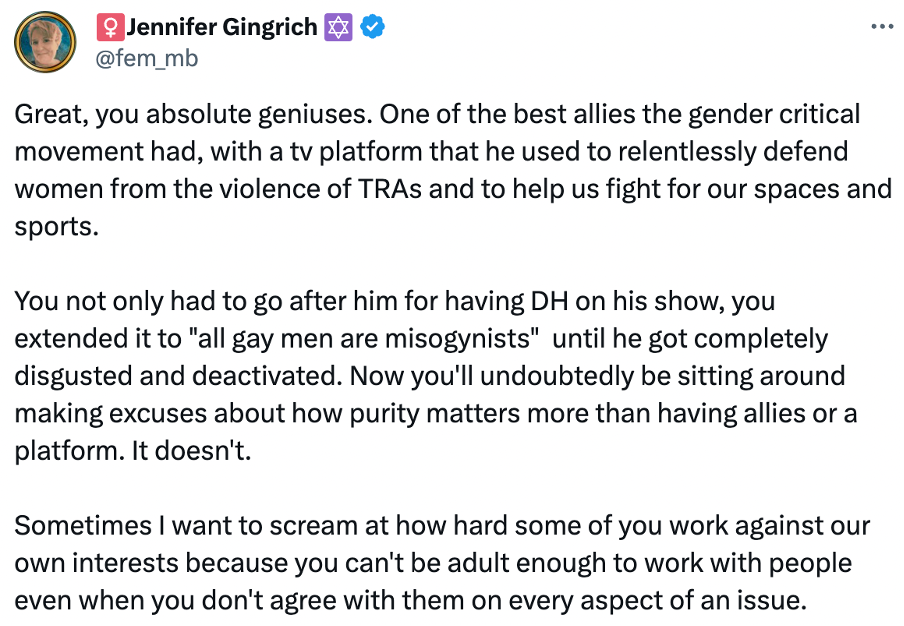
The "has been closed" link (referring to Tavistock) seems to be an incorrect URL.